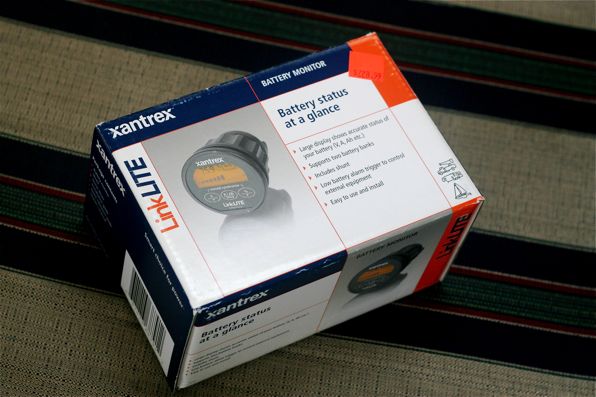No more guessing!
One of our biggest challenges this season, as we have been spending more and more time away from the dock, is energy management, and I’m not talking about conserving my energy for all of the workouts that Rebecca makes me do. I’m talking about the electricity available from our battery bank. The battery monitor that our boat came with is the Link 1000. It works fine as the controller for the inverter I suppose, but it is definitely inadequate for a battery monitor.

As you can see in the pic above, the Link 1000 shows the batteries voltage in 0.5V increments. Given that we only have a couple of volts to play with, that isn’t super helpful. It also does not show anything to do with charging current or power being expended. And without this type of info, we were always forced to be cautious and return to the marina to recharge, quite likely before it was required.
Enter the LinkLite, what we hope will be a much more helpful battery monitor.

Assured by my friend Jeff that installing this unit would be easy, I took the plunge and bought it. My initial plan was to wait until we got to the US and install it while on route but the ease of having Pride Marine right around the corner from us swayed me to do the installation now rather than waiting. So, just to clarify, even though I was assured this job would be easy, I have to say that any job that requires me to wrestle with 2/0 wires (those are BIG-ASS WIRES) in small cabinets is not what I consider easy. Now with that off my chest, the job was completed in 3 hours and with only 1 HUGE electrical shock (@#$%^%@ that hurt).
Note: when you keep turning the power on and off to test things, it’s easy to forget whether it’s on or off. 🙁

Rebecca’s turn to take pics while I work.

A wicked lightning storm did blow up here while we were installing the LinkLITE but this mess was caused by me and not it.

Done (but not yet programmed)!


Nice job……The best thing about installing items on your own is that you learn about that system…….Knowing your systems will come in handy down the road…..Murphy’s law……It is always quicker, easier and more money to have installed by professional, but if I was taking off for a period of time, I would want to know the boat inside and out…….By the way Mike, are you a natural blond?
Thanks John. I agree about doing jobs yourself, although it can be painful while working through them (literally in this case).
As for the blond, it’s the SUN. 😉
We have a Link 2000 on Eolian, and I am sooo glad I installed it.
You’re going to love this thing!
bob
I’m sure I will.
After a good anchor, probably the next best money we spent on the boat was the battery monitor. The net amp flow alone is extremely valuable. If you switch on the anchor light while watching the net amps you will know it came on without having to lean over the lifelines and crane your neck to confirm it is on.
Wait a minute… you installed an LED anchor light. You will have to watch very closely to see the change. 😉
Congratulations on the install.
I didn’t check the readings with the anchor light, but I was playing around with it, watching the values change as I turned other items on and off. I’m sure this will be very helpful for us. Even worth the shock I got installing it I bet.
Well done, Mike! Time for you to do the work and let Rebecca take the pictures!
We’ll take turns. 🙂
Mike,
The battery meter you’ve chosen is essentially an updated version of the one we used on the Queen’s solar cars a few years ago. Once you figure out the controls on the thing, I’m sure you’ll find it to be quite a useful tool.
They don’t do the solar car thing there any more, do they?
No, the team does houses and other (more ‘practical’) solar technology applications now, http://www.qsdt.org/
Interesting. I had heard that once a solar panel dropped in some tiny bit of efficiency they (when they were working on the car I guess) either sold they cheaply or gave them away. Any truth to that?
That’s how we got some of them, yes. Cells that were meant for military or communications satellites, but didn’t make the top bin in the final QC checks (for being, perhaps, slightly off colour or coming in at 26% efficiency instead of 27%). We’d give leftover cells to schools and such now and then, but I don’t recall ever having large surplus quantities.
Once on the car, they don’t tend to last too long- space grade cells are fragile, and protective encapsulation used to be pretty heavy. We used standard terrestrial silicon (Sunpower A300 cells) for our final car in ’07, along with a relatively new laminate encapsulation- think 20% efficient high-output panels, but in the thin, slightly flexible form factor you see in the low-grade, 5% efficient amorphous panels sold as iPod and laptop chargers. Six square metres of these laminates would give us a bit over a kilowatt and weigh something like 40 kg. I think they’d be seriously great for a cruising yacht, but the prices are still a bit too high.
Thanks for the added info, Matt.